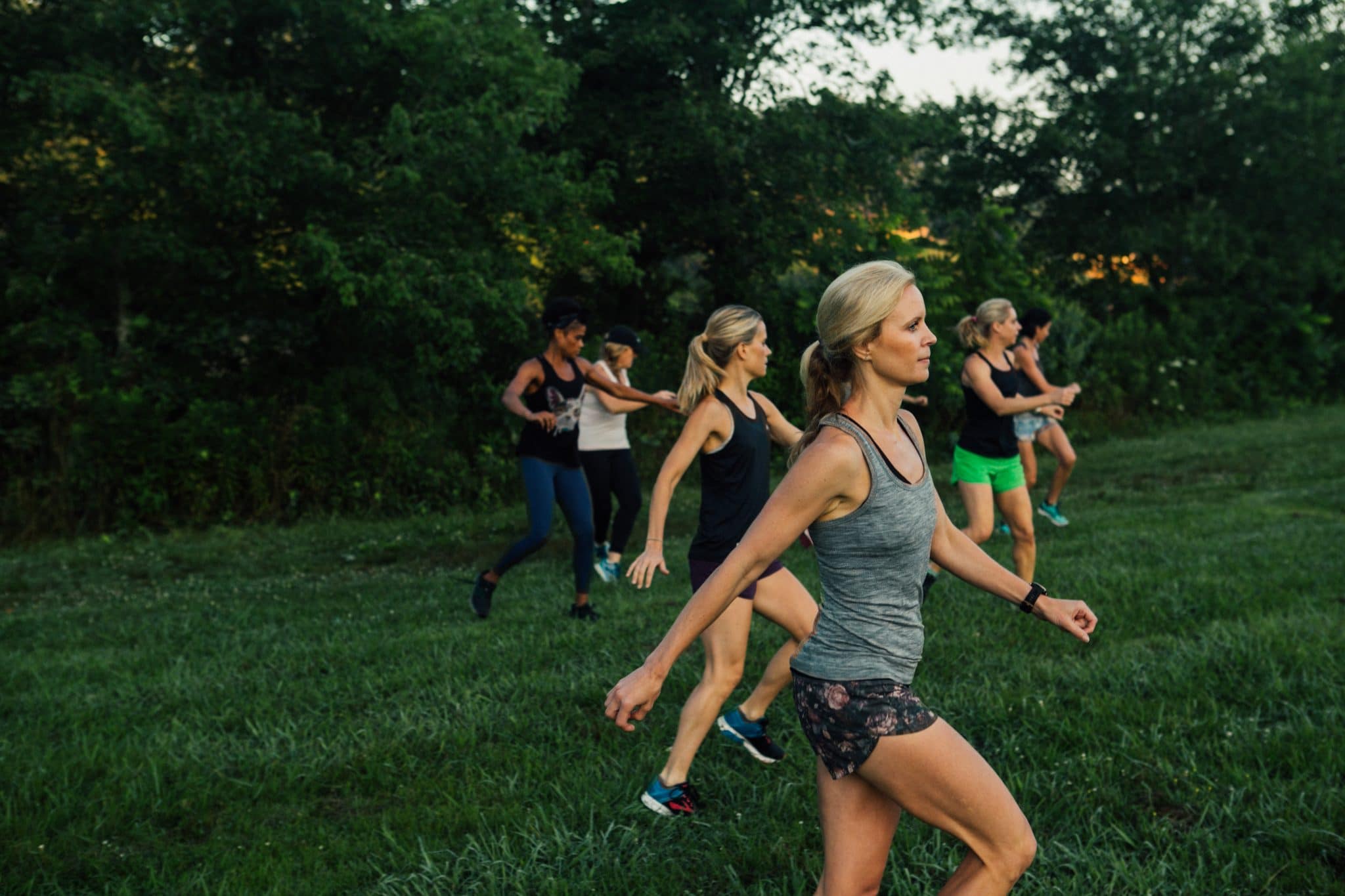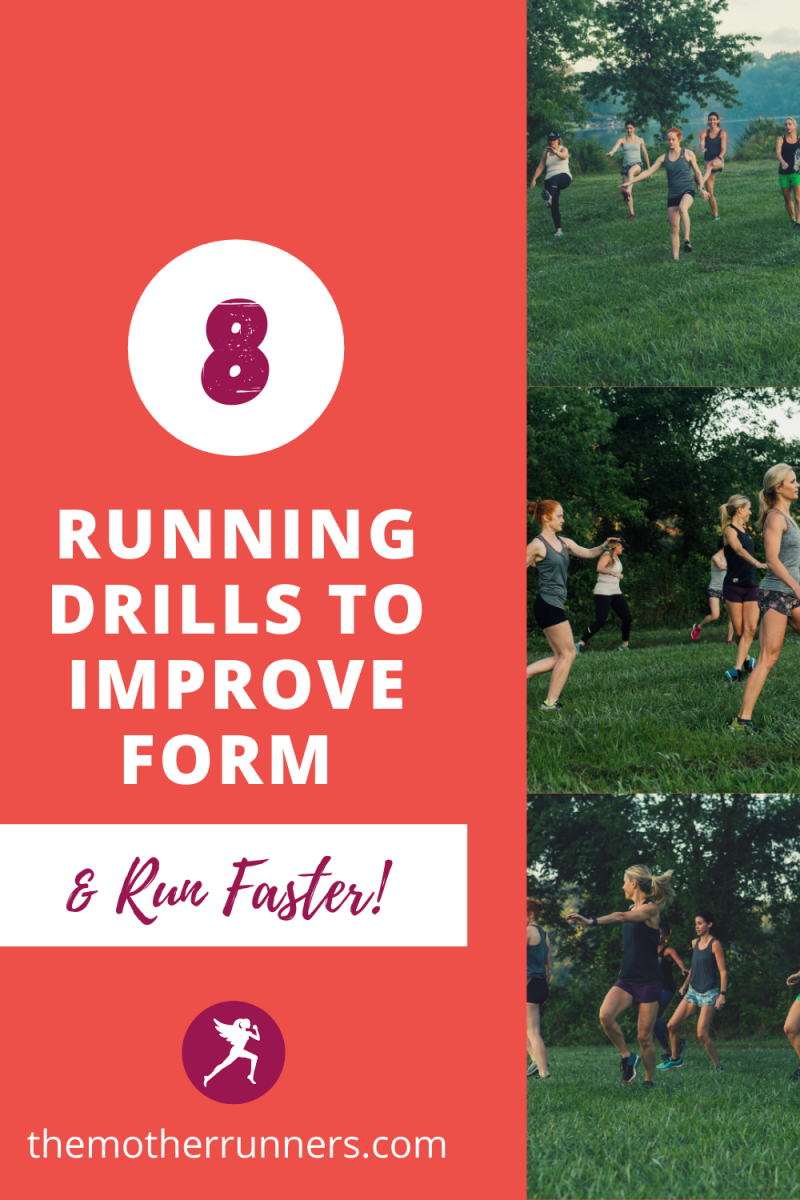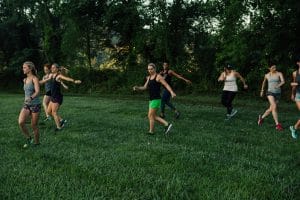Running drills increase neuromuscular fitness to help you run faster using less energy. Do these 8 running drills before a run a couple of times a week.

We all want to run faster. But SHOCKER!, to get faster doesn’t always require running fast or running more. Running drills are an effective way to run faster and improve proper running form. They do this quite simply by improving your neuromuscular coordination and strength.
When I decided to try to qualify for the Olympic Trials in one shot in 2020, having to shave lots off my marathon time, I needed all the help I could get to teach my body to run a faster pace over long distances. This meant
paying attention to all the little things including running drills. Doing this technical work takes focus, high frequency, and consistent practice. But I promise you will notice over time improved coordination and power in your stride.
Skip Ahead
Let’s hop to it!
Benefits of Running Drills
I’m guessing you did running drills when you were on a sports team as a kid. Time to kick it old school again and get back to it.
Running drills help:
- running with good form;
- strengthen your joints and the major muscle groups recruited in running including your calves, quadriceps, hip flexors;
- hamstrings, and core;
- improves lateral mobility instead of singular movement in the sagittal plane (front to back);
- increases injury prevention by improving balance and coordination;
- strengthens communication between the nervous system and the brain to improve power and efficiency.
- increasing the range of motion in your joints helping you run more efficiently; and
- developer quick feet, acceleration, and power by mimicking each aspect of proper form.
In short, these exercises give you more spring in your step so you can propel off the ground faster and further.
When Should You Do Running Drills?
Ideally, you should do drills after a warm-up of a half-mile to two miles. This ensures your muscles are warm and ready for an increased range of motion. If you do not have time to do running drills as part of your run, it is still beneficial to do them when you are hanging out with your kids in the yard or even around the house.

How Often Should You Do Running Drills?
You should running drills two times a week. If you are planning to do speedwork, running drills are an effective way to warm-up the muscles and prepare the joints for faster running. As noted, do these after you have warmed up the muscles by running for a half-mile or two miles.
Related: Heart rate training for runners.
How Long Does it Take to Run Faster with Running Drills?
After about two months, consistent running drills will translate into faster, more powerful running and proper running form. Some runners may even notice a change in more proper running form after just a couple of weeks.
Proper running form, says Patrick Gildea, director and head coach at Knoxville Distance Project, means you are moving in the most energy-efficient way possible. That means your head is over your shoulders, shoulders over hips, hips over mid-foot (not heel), arms are bent at 90-degrees swinging near your sides, and fingers are lightly placed together like you’re holding one potato chip between your index finger and thumb.
Run coaches caution runners to not try to alter their running form overnight.
“Sometimes runners will watch videos of other runners or video themselves running, and then they want to change their stride,” says Bobby Holcombe, head coach and founder of Knoxville Endurance. “Everyone has a different stride, foot strike, etc. They shouldn’t try to change them immediately.”
Instead, focus on simple exercises that will help you gradually improve your posture and become a more efficient runner. He recommends beginning runners add certain exercises to their routine.
Related: How to Fix Your Running Form
Who Should Do Running Drills?

Anyone should do running drills! You do not need to be an elite or really competitive runner to do running drills. They are beneficial to all levels of runners as they improve the mind/body connection thereby reinforcing proper mechanics and improving form.
The only runners who should proceed with caution with running drills are those coming back from injury. Drills should not hurt. If they do, stop! Also, the focus of drills should be your form. Do not rush through them. Take your time and focus on movement rather than distance.
Where Can I Do Running Drills?
The only requirement for running drills is a flat surface and a bit of space. Ideally, you will do them on the road or track on which you run. I often fold them into my run if I am running to the track as a warm-up. It’s also not uncommon for me to get the kids to do drills with me around the house in case I didn’t have time to do them during my run.
What Running Drills Make You Run Faster
Below are the best speed running drills to make you a better runner. Add them to your training plan for after easy runs or before speed workouts or races. Do each drill for 20 yards each with rest periods in between. Maintain an upright posture and quick feet (little ground contact).
The following exercises are speed training drills that make you a better athlete thanks to improved neuromuscular coordination and strengthen:
- High Knees: Run with a high knee lift–knees pushing up to your waist in quick steps. View a demo here.
- A-Skips: Skip forward, lifting your lead knee up to your waist while keeping your back leg straight as you hop off your toe. Continue doing this alternating legs and hitting the ground with your mid-foot or forefoot. See a demo here.
- B-Skips: Skip with high knee motion and extend your leg. Push it down with an eccentric contraction of the hamstring. Alternate legs. See it here.
- Butt-kicks: Run and push your legs back so that your heels come close to your butt. See a demo here.
- Straight leg run or straight-leg bounds: Run with your legs straight in front of you–no bending at the knee. View it here.
- Carioca drill: Face sideways and cross your trailing leg in front and then behind and you continue in the sideways direction. Continue facing the same direction for your return trip. See it here.
- Side-shuffle or side-to-side hop: Extend one leg to the side of your body and shuffle the other leg toward it. Keep your chest up and your feet straight. Return facing the same direction. See it here.
- Backward running: Perform just as it sounds.
Watch my full video demonstration here.
Related: At-home strength training for runners.
Jumping Rope for Runners
Jumping rope is a also great way to get faster because it strengthens the muscles needed to bound off the ground quickly—without the impact on your joints. It may be tiring at first and take some getting used to but jumping rope consistently over a couple of months will pick up your pace, almost guaranteed. In fact, according to the International Sports Conditioning Association, jumping rope will improve your speed, agility, power, endurance, balance, and coordination, all of which are important while running. The association also reports that jumping rope is equivalent to running when it comes to burning calories.
Aim to do a set of 100 rotations twice a week (after an easy run) to see an improvement. If you don’t have a jump rope, you can also hop on your toes a hundred times.
Sprinkle these activities into your week now and see the results in just a couple of months! Go fly, Mother Runners!
If you want guidance with your running goals, including downhill race goals, check out my run coaching services. Also, be sure to check out my free training plans:

This was really helpful!!! Thanks!
Sophia, I am so glad! thanks for sharing!